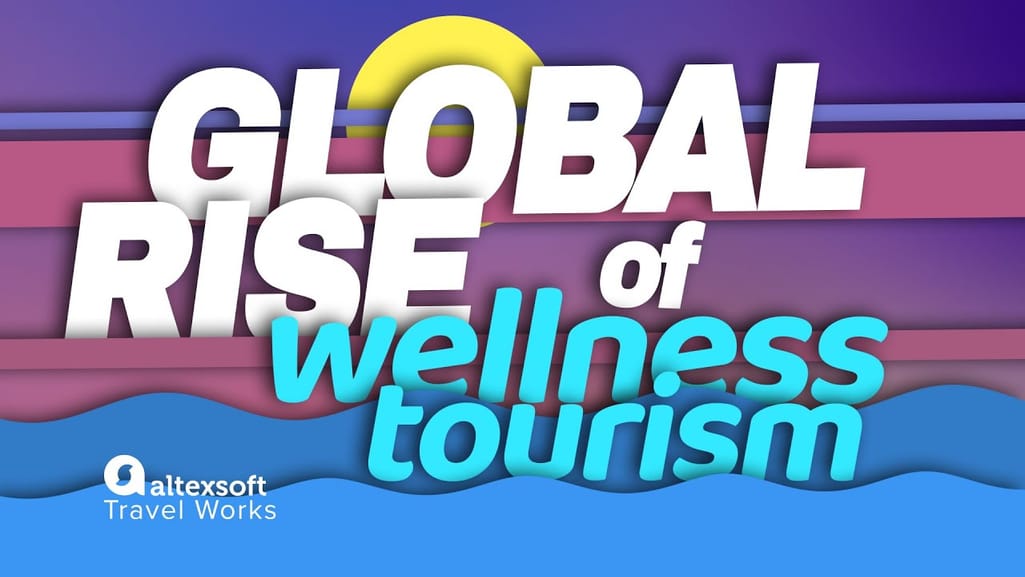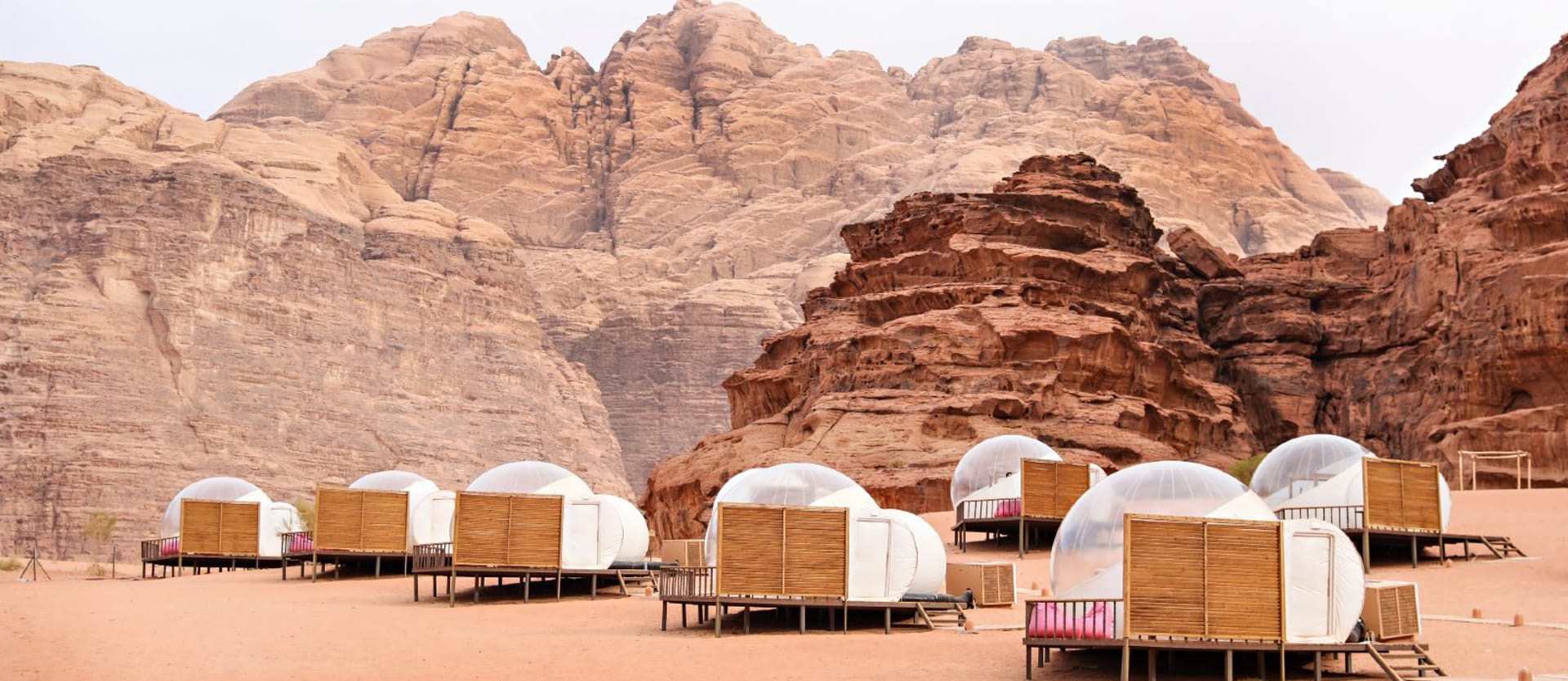There have always been two main types of travelers. Some people don’t mind paying an extra penny or two for comfortable relaxation in all-inclusive hotels, boutique spa resorts, or luxurious cruise ships (drinks by the pool included). On the other side of the spectrum are avid adventure seekers, downshifters, and college students on a budget that are eager to grab a backpack and get off the beaten path to practice yoga in Goa, mingle with the locals in the street bars of Laos – or go camping to the nearest woods and plunge into the simpler life.
The pandemic shifted the balance. Now that the whole world is obsessed with constant hand-washing and social distancing, the first, luxury-loving category would often avoid hotels with their crowded lobbies – to go where? Since many people used to comfort are reluctant to change their habits, the travel market suggested an alternative that combines the service and amenities of an upscale resort with the solitude and tranquility of wild camping.
In this post, we explore glamping as one of the current travel trends, compare it to good old camping, and discuss who chooses to spend their vacation at a glampsite and why they do. We’ll also sneak a peek at digital technologies that help meet guest expectations, so if you are a glamping property owner or thinking of setting up a few designer-outfitted tents, this text is definitely for you.
What is glamping?
Glamping – short for “glamorous camping” – is just what it sounds like: a luxury type of camping. It involves staying in some kind of outdoor accommodation (tents, cabins, yurts, or even treehouses) and enjoying additional services, resort-like amenities, and a variety of activities.
The term glamping was coined in 2005 and recently became one of the biggest travel trends – among other popular portmanteaus like bleisure, staycations, workation, ecotourism, and so on (today people seem to totally love those blends). Its success is easily explained: It precisely hits the sweet spot where travelers yearn for new, unusual experiences, comfort, and distancing.
So here’s what glampsites typically offer:
- electricity,
- heating and cooling,
- Wi-Fi access,
- private bathroom with running water,
- room/laundry service and housekeeping,
- a restaurant or catering service, and so on.
Some glampsites mainly focus on creating an exceptional close-to-wildlife experience, while others are compound parts of bigger resort complexes. Some offer family deluxe multi-room cabins with a rustic touch, while others provide a modernized version of Mongolian-style yurts or fully furnished treehouses from your childhood dream. Some of them are unique in terms of design or location, most are pet-friendly, and all of them aim at providing an outstanding, unforgettable travel experience.
Actually, the sky's the limit for ideas of how glamping property owners attract their guests. For example, Camp Long Creek, a part of the larger Big Cedar Lodge resort, not only boasts king-size beds with chandeliers in their glamping tents located on the bank of Table Rock Lake (plus a shower, a firepit, and an outdoor tub) but also offers access to numerous Big Cedar amenities like golf courses, full-service marina, a shooting academy, and all sorts of outdoor activities.
A family glamping unit at Camp Long Creek
Well, this is what a classic glamping tent looks like. For those travelers who crave something even more offbeat and unusual, the glamping world has also got an offer or two. How about staying in refurbished, comfy windmills in Lemnos, Greece? Or in the floating cabin in the middle of the lake at the French Echologia resort? Or maybe you want to watch the sky from a transparent panoramic roof bubble room in Villahermosa, Spain?
Hotel Zielo Las Beatas, Spain
Looks cool, huh? We’re sure you get the idea but still, let’s briefly elaborate on how glamping is different from its big brother – camping.
Glamping vs camping
Obviously, the main difference between the two concepts lies in the amenities and the scope of services provided. With wild camping you get, well, none. Campers have to pitch their tent, cook food, and manage waste all by themselves. It's also worth noting that wild camping is illegal in some countries.
If you visit a traditional campground, you get access to a more or less civilized restroom and shower. Some sites also provide firewood and have picnic tables, firepits, and, rarely, a small convenience store.
Glamping is a completely different story. Travelers don’t have to put up a single tent pole or worry about food, water, cleanliness, or warmth. They basically get all the services of an upscale hotel – except they sleep in a canvas tent instead of the multistory building.
Glamping pros and cons
Just like anything in our lives, glamping isn’t a one-size-fits-all travel mode, despite its obvious balance between comfort and outdoor experience. So let’s spend a moment reflecting on its pros and cons (compared to camping).
Since not everyone wants to completely strip their lives down to the bare essentials, glamping pros include:
- more comfort allowing travelers to support their usual lifestyle and completely relax;
- no need for special skills or knowledge of how to set up a tent, chop wood, or cook on open fire;
- more safety and protection from various risks – from wildlife to lack-of-hygiene infections to weather/temperature changes;
- no need for specialized equipment or camping gear which is often quite costly; and
- greater accessibility, especially for people with disabilities.
However, if the target is getting as close to nature as possible and spending a night in a sleeping bag doesn’t scare you away, glamping loses the battle to camping because of its cons:
- less direct interaction with nature and a watered-down adventure experience;
- fewer educational and skill development opportunities;
- fewer essential joint activities (to overcome the difficulties of traditional camping) that create special bonding; and
- arguable sustainability issues since many glampsites consume a lot of energy and water and create excessive waste (well, this one depends on the property).
Now that we know what glamping is and what it’s not, let’s turn around and look at the other side – the travelers. Who are these glamping lovers and why do they prefer this travel type?
Which travelers choose glamping and why?
Before we describe the typical glampsite guest, let’s say a few words about what’s important for global travelers today.
Current travel trends
It goes without saying that the pandemic has changed people’s preferences, so here’s what many travelers now prioritize:
- Off-grid style vacations allow them to completely unplug and get back to nature (as reported by 58 percent of the Booking.com survey respondents);
- “Out of comfort zone” travel is a sought-after experience for 74 percent of respondents as it involves exploring new places, trying new food, experiencing new emotions, and plunging into unconventional adventures;
- Interestingly though, having phone and internet connection at the destination is still the requirement for most people as they don’t really want to go totally off the grid;
- Family reunions and multigenerational travel to reconnect and re-engage are important for 79 percent of the American Express survey respondents;
- Sustainability of all types matters for 81 percent of travelers (as stated in the Sustainable Travel Report 2022). It means being mindful about minimizing waste and resource consumption, connecting to and benefiting local communities, traveling during the off-peak season, or opting for greener transportation and regional trips to decrease carbon footprint; and
- Wellness getaways help refresh and restore mind, body, and soul through spa treatment, meditation, and relaxation.


Watch a cool video about wellness travel trend
Some other top trends today are nostalgic travel and bucket list trips. It’s also obvious that travelers pay more attention to health and safety procedures at the destination and often prefer a contactless experience to minimize the risks.
Looking at these prevailing trends, it becomes clear that glamping hits most of them, giving travelers an excellent combination – an adventurous experience close to nature with lots of exclusive activities available, yet in comfortable conditions with all safety measures maintained.
That being said, let’s finally examine the glamping market and see what travelers say about it.
The glamping market research
The glamping market is undoubtedly on the rise and is anticipated to grow at a compound annual growth rate (CAGR) of 14.7 percent from 2022 to 2027. It means that the demand is growing and it’s a good time to launch such a business if you’re considering it. But since the main goal of any travel company is customer satisfaction and you as a property owner must know your customer, let’s look closer at your potential guests and their needs.
Who chooses glamping and why
The IMARC Group survey states that the age group of 18-32 is the one that’s most interested in glamping, with 4-person cabins and pods being the most popular accommodation type.
The Grand View Research survey findings are similar in all aspects. The research also shows that glamping amenities such as Wi-Fi connection, kitchens, bathrooms, and pools are of great importance to the guests.
Additionally, they’ve discovered increasing interest in wedding glamping among millennials and Gen Zs.
It also confirms our conclusions reporting that “Key factors that are driving the glamping market growth include a rise in eco-tourism and consumer inclination toward adventure travel and the rising popularity of wellness tourism owing to the increasing number of travelers.”
In 2019, a survey “Dimensions of Service Quality in Glamping” was conducted in Croatia. It showed that the factors that matter most to guests are staff friendliness, cleanliness, and staff professionalism. As for glamping facilities, guests value an attractive and well-maintained natural environment as well as the glampsite location, while comfort was ranked third.
The 2021 Consumer Research on Glamping surveyed travelers from Australia, the UK, and the US. It identified the main market expectations that include
- comfort and climatic considerations (heating and cooling),
- unique design (a better look was found to justify a higher price),
- setting and location (isolated but not overly remote areas were rated highly),
- destination meaning proximity to an interesting site, and
- experiences.

Hierarchy of key elements for glamping, source: Consumer Research on Glamping in WA
Another important finding concerned a glampsite's marketing strategy. The survey states that it’s crucial to develop a rich understanding of the experience, mainly through high-quality pictures and detailed descriptions. Besides, a strong web presence is essential, including both its own well-organized website and other distribution channels to simplify the planning and booking stages of the customer journey.
That brings us to the next important section of our discussion, namely, the technological aspect of a glamping business.
Technologies for a glamping business
Hotels, vacation rentals, and other types of alternative accommodations heavily rely on various technologies to streamline their daily activities and maximize customer satisfaction. Glamping aims at providing guests with the utmost experience, so it can’t avoid implementing modern devices and systems to attract travelers, enhance their satisfaction, and gain a competitive advantage.
Note that we’re not going to describe the tangible, physical tools like computers or off-grid technologies like solar panels (which are certainly important) but focus on the software.
Property management system for all-encompassing operational control
A property management system or PMS usually serves as the backbone of a hospitality business, automating multiple reservation and administrative workflows.


How a PMS works
Whether you operate a resort or a glampsite, a PMS would typically include several key modules that cover the main operational workflows:
- reservation management with a user-friendly calendar to accurately schedule bookings,
- front-desk module to handle check-ins and checkouts,
- channel management tool to efficiently control distribution processes,
- housekeeping and task scheduling to manage staff,
- revenue management to operate rates and set up a dynamic pricing system, and
- payment processing to accept transactions.
Sometimes, a comprehensive PMS also comprises a point-of-sale system to manage cross-selling efforts and revenue from multiple sources, a CRM to handle customer relationships and marketing activities, and an accounting tool. Besides, most PMS providers offer a prebuilt integration with the major booking platforms to facilitate distribution.
Today, there are several PMS platforms designed specifically for glamping properties. For example, you can check out GlampManager or customized solutions by Lodgify and Guesty.
GlampManager’s Dashboard
As you might notice, all of them offer the basic functionality to manage the main daily workflows and also include a website builder with a booking engine. Let’s talk about it separately.
Pro tip: Within the reservation management workflow, be sure to automate your communication with guests by sending them the booking confirmation, a friendly reminder prior to their visit with directions and other important information, and a follow-up message with gratitude and a feedback request.
Website builder and a booking engine to develop a powerful web presence
As we said above, creating a strong web presence is a crucial element of your success, so a website builder can be a handy instrument to devise an attractive, engaging website. Its interface and usability will most probably be that first, often decisive, impression, so be sure to make it an easily navigated attention grabber.
In addition to alluring pictures and descriptions, consider creating an interactive virtual 3D tour of your glamping property so that your guests can see what’s inside and choose exactly what they desire. Check out Night Sky Glamping or Birdholme Glamping websites as examples of how it might look.
It’s also important to drive direct bookings so provide your guests with a simple and intuitive tool to make online reservations. That's what a booking engine is responsible for. If possible, add a booking functionality not only for lodging but also for tours and activities that you offer.


Here’s why direct bookings are important
Even though we realize the value of direct bookings, it still makes sense to diversify your distribution strategy, especially at the early stages of your growth, so now we’ll look closer at channel managers.
Pro tip: Add a knowledge base or an FAQ section to your website. This way, you’ll avoid repetitive questions, enable your guests to get additional information, and have ready links at hand that you can send to those who still ask instead of checking the help desk :)
Channel manager to handle distribution
A channel manager is a piece of software that controls distribution across multiple channels. In other words, if you want to sell your glamping units through Booking.com, Airbnb, and specialized websites, a channel manager will collect reservation details and automatically sync rates and availability throughout all platforms. This way, you avoid overbooking and double booking without having to manually adjust information everywhere.
We’ve written a lot about hotel channel managers, vacation rental channel managers, and custom channel managers, so you can follow the links for more details and a providers’ overview.
Pro tip: Balance your distribution by using both popular booking sites and focused glamping/camping platforms such as Hipcamp, Glamping.com, or GlampingHub. As you develop, monitor and analyze their performance and profitability and adjust your distribution strategy accordingly
Contactless technologies for top guest convenience
Many travelers choose glamping for its solitude and appreciate the opportunity to be alone with themselves. Offer them a contactless experience through a smartphone app or a virtual concierge. Such technologies enable digital check-in and checkout, requesting and booking additional services, convenient communication via a chatbot or inbuilt messenger, digital keys, payment processing, and other self-service options.
Pro tip: Localize your app – and your website too by the way – to make it international user-friendly
Smart technologies for fuller control
Glamping suggests luxury and comfort, so to follow current upscale hotel trends, consider taking advantage of modern Internet of Things connected devices and other smart technologies. That includes motion sensors, voice assistants, facial recognition, predictive maintenance, and so on. Read our smart hotel trends overview for more ideas.
Pro tip: Don’t rush to implement all at once and do build a seamless integration between all systems and interfaces. It’s an effort- and time-consuming project but the results are worth it
More ideas on how to succeed in the glamping industry
In conclusion, we want to give several recommendations on how you – as a current or potential glamping business owner – can attract more guests and increase their satisfaction.
Start marketing soon. A common mistake is starting to promote your property after you launch it. Don’t hesitate to advertise as early as possible to enjoy the first visitors right after you open up.
Remember the power of social media. Currently, Instagram and TikTok both have over 1 billion active users and Facebook has almost reached 3 billion, so take the opportunity to reach your guests right where they are.
Encourage reviews and react to them. Ask your visitors to share feedback on any platform (e.g., Google Maps, TripAdvisor, Booking.com, etc.) and do your best to reply to them. It will make your guests feel special, show you where you can improve, and tell potential visitors about what to expect.
Make an Instagrammable location. People enjoy showcasing their lives on social media. Create a unique, picturesque spot within your property to make your guests excited about taking pictures – and have them hashtag your company in the media to add to your advertising!
C Lazy U Ranch Conestoga glamp unit
Think about adding wellness options. Vacations are often seen as the time to pamper oneself, improve health, and immerse in pleasant experiences. Wellness travel is on the rise and it usually isn’t too expensive to incorporate, so think if you can add a spa, a yoga class, or other health-focused activities to your entertainment portfolio.
Showcase your sustainability undertakings. Today, 4 out of 5 travelers would rather choose a sustainable accommodation option, so promote your activities, whether it’s buying produce from local farmers, planting trees, reducing resource consumption, or donating to charities.
Surprise your guests. Think of other ways you can create an outstanding experience for your guests – at the end of the day that’s what will bring them back and make them share their excitement on social media and promote you to their friends. It can be a complimentary drink on arrival, an unusual way of serving food, a little local souvenir at check-out, or anything else that will be pleasant, unexpected, and have a wow-effect.
Create a shared space. A communal area where your guests can gather together and socialize with other visitors is what’s often greatly appreciated on glampsites. Think of a stargazing point or a big fire pit or maybe purchase a few board games and encourage such joint activities. It’s also something that will help your guests build great memories, becoming loyal customers and attracting new ones.
Check out the cozy indoor shared space at Claremorris Glamping and the outdoor communal firepit at Valley View Glamping
Choose your customers, focus on their needs, and make them happy. We listed the hottest travel trends above, but you have to choose your own audience and center your attention on their interests and desires. You can observe who’s visiting your competitors, analyze your location, and look at available resources, but you have to clearly understand your guests, who they are, and what they need.
We said that many people want to have Wi-Fi connection – but at the same time there are lots who dream about completely unplugging and indulging in a digital detox. You can cater to families with kids and showcase a playground and family activities – or focus on couples who are looking for romantic getaways and would appreciate a bottle of wine on the house.
So define your customers, direct your design and marketing efforts to creating exceptional experiences for them and fulfilling their dreams - and you’ll be rewarded with their loyalty.

Maria is a curious researcher, passionate about discovering how technologies change the world. She started her career in logistics but has dedicated the last five years to exploring travel tech, large travel businesses, and product management best practices.
Want to write an article for our blog? Read our requirements and guidelines to become a contributor.

